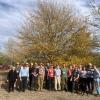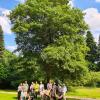Editor's Picks
Plant Focus
Poster presented at the XX International Botanical Conference, Madrid, Spain, July 21–27, 2024.
Authors:
Xiangbo Yin1,2, Susanne Walden1, Eric Martiné1, Lars Opgenoorth1, Maaike Y. Bader1
Affiliations:
1. Philipp University of Marburg, Marburg, Germany
2. National Institute of Scientific Research, Quebec City, Canada
Abstract:
Functional traits offer mechanistic insights, precise metrics, and predictive capabilities for assessing the physiological status, fitness, and even broader ecosystem processes and responses of plants. Leaves, comprising both the phyllosphere (exterior) and endosphere (interior), represent a widespread and diverse habitat for microbiota. Those microorganisms in leaves not only promote host fitness and nutrient acquisition, but also play important roles in global biodiversity and biogeochemical cycles. However, understanding the relative contributions of host-associated and environmental factors in determining host microbial community composition as well as the primary mechanisms within a host that mediate host-microbe interactions, remains a challenge in microbial ecology. To address the questions, the common oak (Quercus robur L.), a main forest-forming species in European forest ecosystems, was chosen to determine and quantify the interaction between leaf functional traits and microbial community structure and functions. Both field and greenhouse experiments were designed to focus on intraindividual (e.g., canopy position, leaf sides), intraspecific (e.g., site-specific conditions), and temporal variations (e.g., growth stages) as potential drivers of functional trait-microbial interactions. Morphological (e.g., specific leaf area and dry mass), physiological (e.g., photosynthetic rates and surface wettability) and chemical properties (e.g., nutrient concentrations, metabolite production) were measured to represent the leaf functional traits. Furthermore, to determine potential influence of global changes on leaf functions, we will design experiments to evaluate how these properties change under drought and heat. This project aims to unravel the complex interaction between plant functional traits and leaf microbiota, thereby informing potential mitigation strategies to safeguard plant fitness and ecosystem stability to global changes.We will present the concepts used in this project as well as the preliminary results.
















